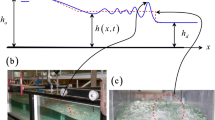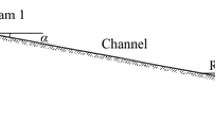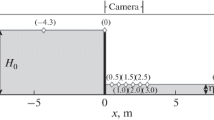Abstract
Dam-break flood waves are associated with major environmental disasters provoked by the sudden release of water stored in reservoirs. Ritter found in 1892 an analytical solution to the wave structure of an ideal fluid released during an instantaneous dam failure, propagating over initially dry horizontal terrain. This solution, though ideal, hence frictionless, is widely used to test numerical solutions of the Shallow Water Equations (SWE), and as educational tool in courses of fluid mechanics, given that it is a peculiar case of the Riemann problem. However, the real wave structure observed experimentally differs in a major portion of the wave profile, including the positive and negative fronts. Given the importance of an accurate prediction of the dam break wave, the positive and negative wave portions originating from the breaking of a dam with initially dry land on the tailwater reach are revisited in this work. First, the propagation features of the dry-front are investigated using an analytical boundary-layer type model (Whitham/Dressler/Chanson model) constructed matching an (outer) inviscid dynamic wave to an (inner) viscous diffusive wave. The analytical solution is evaluated using an accurate numerical solution of the SWE produced using the MUSCL-Hancock finite-volume method, which is tested independently obtaining the solution based on the discontinuous Galerkin finite-element method. The propagation features of the negative wave are poorly reproduced by the SWE during the initial stages of dam break flows, and, thus, are then investigated using the Serre–Green–Naghdi equations for weakly-dispersive fully non-linear water waves, which are solved using a finite volume-finite difference scheme.














Similar content being viewed by others
References
Chanson H (2004) The hydraulics of open channel flows: an introduction. Butterworth-Heinemann, Oxford
Ré R (1946) Étude du lacher instantané d’une retenue d’eau dans un canal par la méthode graphique. La Houille Blanche 1(3):181–188
Jain SC (2001) Open channel flow. Wiley, New York
Sun S, Leng X, Chanson H (2016) Rapid operation of a tainter gate: generation process and initial upstream surge motion. Environ Fluid Mech 16(1):87–100. doi:10.1007/s10652-015-9414-3
Toro EF (2001) Shock-capturing methods for free-surface shallow flows. Wiley, Singapore
Ritter A (1892) Die Fortpflanzung von Wasserwellen. Zeitschrift Verein Deutscher Ingenieure 36(2):947–954
Khan AA, Lai W (2014) Modeling shallow water flows using the discontinuous Galerkin method. CRC Press, Taylor and Francis, New York
Barré de Saint-Venant AJC (1871) Théorie du mouvement non permanent des eaux, avec application aux crues des riviéres et à l’introduction des marées dans leur lit. C R Séances Acad Sci 73:147–154
Toro EF (2009) Riemann solvers and numerical methods for fluid dynamics: a practical introduction. Springer, Berlin
Lauber G (1997) Experimente zur talsperrenbruchwelle im glatten geneigten Rechteckkanal, VAW-ETH. Ph.D Thesis, Zürich
Dressler RF (1952) Hydraulic resistance effect upon the dambreak functions. J Res Natl Bureau Stand 49(3):217–225
Whitham GB (1955) The effects of hydraulic resistance in the dam-break problem. Proc R Soc Lond 227(Serie A):399–407
Shigematsu T, Liu PL-F, Oda K (2004) Numerical modeling of the initial stages of dam-break waves. J Hydraul Res 42(2):183–195
Chanson H (2009) Application of the method of characteristics to the dam break problem. J Hydraul Res 47(1):41–49. doi:10.3826/jhr.2009.2865
Lauber G, Hager WH (1998) Experiments to dambreak wave: horizontal channel. J Hydraul Res 36(3):291–307
Oertel M, Bung DB (2012) Initial stage of two-dimensional dam-break waves: laboratory versus VOF. J Hydraul Res 50(1):89–97
Dressler R (1954) Comparison of theories and experiments for the hydraulic dam-break wave. In: Proceedings of the International Association of Scientific Hydrology Assemblée Générale, vol 3, no. 38. Rome, pp 319–328
Steffler PM, Jin YC (1993) Depth-averaged and moment equations for moderately shallow free surface flow. J Hydraul Res 31(1):5–17
Khan AA, Steffler PM (1996) Vertically averaged and moment equations model for flow over curved beds. J Hydraul Eng 122(1):3–9
LeVeque RJ (2002) Finite volume methods for hyperbolic problems. Cambridge University Press, New York
Schoklitsch A (1917) Über dambruchwellen. Kaiserliche Akademie der Wissenschaften, Wien, Mathematisch-Naturwissenschaftliche Klasse, Sitzungberichte IIa 126:1489–1514
Hesthaven JS, Warburton T (2008) Nodal discontinuous Galerkin methods: algorithms, analysis, and applications. In: Texts in applied mathematics 44. Springer, New York
Hoffman JD (2001) Numerical methods for engineers and scientists, 2nd edn. Marcel Dekker, New York
Serre F (1953) Contribution à l’étude des écoulements permanents et variables dans les canaux. La Houille Blanche 8(6–7), 374–388; 8(12), 830–887
Su CH, Gardner CS (1969) KDV equation and generalizations. Part III. Derivation of Korteweg-de Vries equation and Burgers equation. J Math Phys 10(3):536–539
Green AE, Naghdi PM (1976) Directed fluid sheets. Proc R Soc Lond A 347:447–473
Green AE, Naghdi PM (1976) A derivation of equations for wave propagation in water of variable depth. J Fluid Mech 78:237–246
Castro-Orgaz O, Hager WH (2014) 1D modelling of curvilinear free surface flow: Generalized Matthew theory. J Hydraul Res 52(1):14–23
Mohapatra PK, Chaudhry MH (2004) Numerical solution of Boussinesq equations to simulate dam-break flows. J Hydraul Eng 130(2):156–159
Barthelemy E (2004) Nonlinear shallow water theories for coastal waters. Surv Geophys 25(3):315–337
Cienfuegos R, Barthélemy E, Bonneton P (2006) A fourth-order compact finite volume scheme for fully nonlinear and weakly dispersive Boussinesq-type equations. Part I: model development and analysis. Int J Numer Methods Fluids 51(11):1217–1253
Dias F, Milewski P (2010) On the fully non-linear shallow-water generalized Serre equations. Phys Lett A 374(8):1049–1053
Bonneton P, Chazel F, Lannes D, Marche F, Tissier M (2011) A splitting approach for the fully nonlinear and weakly dispersive Green–Naghdi model. J Comput Phys 230(4):1479–1498
Castro-Orgaz O, Chanson H (2011) Near-critical free surface flows: real fluid flow analysis. Environ Fluid Mech 11(5):499–516. doi:10.1007/s10652-010-9192-x
Nakagawa H, Nakamura S, Ichihashi K (1969) Generation and development of a hydraulic bore due to the breaking of a dam. Bull Disas Prev Inst Kyoto Univ 19(154):1–17
de Almeida AB, Franco AB (1994) Modeling of dam-break flow. In: Chapter in computer modelling of free surface and pressurized flows. Nato Science Series E, Springer, Berlin, pp 343–373
Stansby PK, Chegini A, Barnes TCD (1998) The initial stages of dam-break flow. J Fluid Mech 374:407–424
Mohapatra PK, Eswaran V, Murthy Bhallamudi S (1999) Two-dimensional analysis of dam-break flow in a vertical plane. J Hydraul Eng 125(2):183–192
Hosoda T, Tada A (1994) Free surface profile analysis on open channel flow by means of 1-D basic equations with effect of vertical acceleration. JSCE Ann J Hydraul Eng 38:457–462
Hosoda T, Tada A, Inoue K, Kitahara M (1994) Hydraulic analysis of unsteady flows with propagation of an interface between free surface flow and pressurized flow. Doboku Gakkai Ronbunshu 503/II-29:89–97
Tonelli M, Petti M (2009) Hybrid finite volume-finite difference scheme for 2DH improved Boussinesq equations. Coast Eng 56(5–6):609–620
Wei G, Kirby JT, Grilli ST, Subramanya R (1995) A fully nonlinear Boussinesq model for surface waves 1: highly nonlinear unsteady waves. J Fluid Mech 294:71–92
Erduran KS, Ilic S, Kutija V (2005) Hybrid finite-volume finite-difference scheme for the solution of Boussinesq equations. Int J Numer Methods Fluids 49(11):1213–1232
Kim D-H, Lynett PJ (2011) Dispersive and nonhydrostatic pressure effects at the front of surge. J Hydraul Eng 137(7):754–765
Hosoda T, Iwata M, Muramoto Y, Furuhachi T (1997) Hydraulic analysis of undular bore in open channels with circular cross-section. JSCE Ann J Hydraul Eng 41:645–650
Atrabi HB, Hosoda T, Tada A (2015) Simulation of air cavity bubble advancing into a straight duct. J Hydraul Eng 141(1):04014068-1–04014068-9
Denlinger RP, O’Connell DRH (2008) Computing nonhydrostatic shallow-water flow over steep terrain. J Hydraul Eng 134(11):1590–1602
Ozmen-Cagatay H, Kocaman S (2010) Dam-break flows during initial stage using SWE and RANS approaches. J Hydraul Res 48(5):603–611
Leng X, Chanson H (2015) Unsteady turbulence in expansion waves in rivers and estuaries: an experimental study. Environ Fluid Mech 15(5):905–922. doi:10.1007/s10652-014-9385-9
Stoker JJ (1957) Water waves: the mathematical theories with applications. Wiley, New York
Phole FV (1952) Motion of water due to breaking of a dam and related problems. Symposium on Gravity Waves, Paper No 8, pp 47–53
Brocchini M (2013) A reasoned overview on Boussinesq-type models: the interplay between physics, mathematics and numerics. Proc R Soc A 469:20130496
Kirby JT (2016) Boussinesq models and their application to coastal processes across a wide range of scales. J Waterw Port Coast Ocean Eng 142(6):03116005
Lubin P, Chanson H (2016) Are breaking waves, bores, surges and jumps the same flow? Environ Fluid Mech. doi:10.1007/s10652-016-9475-y
Cienfuegos R, Barthélemy E, Bonneton P (2010) Wave-breaking model for boussinesq-type equations including roller effects in the mass conservation equation. J Waterw Port Coast Ocean Eng 136(1):10–26
Tissier M, Bonneton P, Marche F, Lannes D (2012) A new approach to handle wave breaking in fully non-linear Boussinesq models. Coast Eng 67:54–66
Author information
Authors and Affiliations
Corresponding author
Appendices
Appendix 1: damping model for dispersive terms in Serre–Green–Naghdi equations
Current parametrizations of wave breaking are based on the assumption that the energy dissipation is adequately accounted for by the Rankine–Hugoniot jump conditions of shocks [52,53,54]. Therefore, a Boussinesq + Saint Venant matching approach is adopted. Basically, the wave profile is computed solving the Boussinesq-type equations and, after each time step, a wave breaking criteria is checked in the computational domain. In those cells marked as breaking, the dispersive terms are switched off (equivalent to setting ε = 0), and the SWE are solved there. Other wave-breaking models can be adopted, like the classical diffusive model extensively validated by Cienfuegos et al. [55] or the recent development by Tissier et al. [56]. The wave breaking model proposed by Hosoda and Tada [39] and Hosoda et al. [40], is, however, less known, despite its simplicity and good performance. The idea behind this parametrization is identical to that developed by Tonelli and Petti [41] in the sense that Boussinesq equations are “substituted” by the SWE at breaking cells. However, rather that producing a full (sharp) transition from Boussinesq to the SWE at breaking nodes, they proposed a gradual damping of the dispersive terms when the threshold criteria of wave breaking is exceeded. The method is as simple to implement as that of Tonelli and Petti [41], and permits a very stable behavior of the numerical computations. Below, the physical background of the method is explained.
The idea is to attenuate the dispersive terms of the Serre–Green–Naghdi equations if the local free surface slope exceeds a threshold value. To produce a gradual damping of dispersive terms Hosoda and Tada [39] and Hosoda et al. [40] proposed an exponential attenuation given by
A calibration parameter ς is introduced, and (∂h/∂x) cr is the threshold value of the free surface slope above which wave breaking is initiated. This value was determined using the solitary wave as conceptual model, given that it is a particular solution of the Serre–Green–Naghdi equations. The solitary wave profile (Fig. 15a) is given by [24]
where h 1 is the undisturbed water depth and F1 the corresponding Froude number. The question is then: What is the maximum value of the free surface slope in a solitary wave for incipient wave breaking? Successive differentiation of Eq. (49) produces
where
a Solitary wave profile, b evolution of damping factor in test of Fig. 9
The maximum free surface slope occurs at the inflection point I in Fig. 15a. Thus, setting ∂2 h/∂x 2 = 0 results in
and, using this value of the x-coordinate, the free surface slope at the inflection point is
Based on undular bore experimental data of Favre waves, the limiting supercritical Froude number for wave breaking F1 = 1.25 was adopted [39, 40]. Thus, from Eq. (53) results
This slope is adopted as a threshold value above which wave breaking occurs due to the action of turbulence.
To illustrate the performance of Eq. (48), the test case presented in Fig. 9 is reconsidered in Fig. 15b, where ε = ε(x/h o ) is plotted at T = 1.13 and 2.76. Note the low value of ε just after the dam break, given that the damping model is activated by the upstream vertical water depth just as soon as computations are initiated. Its action is gradually reduced in magnitude and spatial extension as the wave evolves, given the reduction of the free surface slopes. For the remaining computational snapshots presented in Fig. 9 (e.g. T = 3.88, 5.01 and 6.64) the damping model is never activated (ε = 1).
Appendix 2: Ritter’s original work
In this appendix we reprint two original figures from Ritter [6], given their interest for educational purposes. In Fig. 16 we observe the original parabolic profile sketched by Ritter. The quantity (ga)1/2 is denoted by U o , and the celerity of the dry and backward fronts are clearly indicated. The initial water depth in the dam is a, and the critical water depth at the dam axis is (4/9)a.
Parabolic wave solution by Ritter [6]
Ritter [6] noted that his parabolic profile was not in agreement with observations, and sketched a more realistic shape for the dam break curve, where all the profile has negative curvatures, as seen in Fig. 17.
Parabolic wave solution and comparison with a more realistic shape for the dam break curve, after Ritter [6]
Rights and permissions
About this article
Cite this article
Castro-Orgaz, O., Chanson, H. Ritter’s dry-bed dam-break flows: positive and negative wave dynamics. Environ Fluid Mech 17, 665–694 (2017). https://doi.org/10.1007/s10652-017-9512-5
Received:
Accepted:
Published:
Issue Date:
DOI: https://doi.org/10.1007/s10652-017-9512-5







